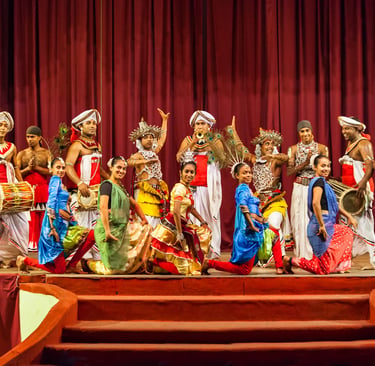Kandyan Dance Performance


Historical Significance
The Kandyan Dance is one of Sri Lanka’s most enduring cultural legacies, tracing its origins back to the ancient royal courts of the Kandyan Kingdom. Traditionally performed during temple rituals and royal ceremonies, it was believed to invoke divine blessings, celebrate victory, and express spiritual devotion. Rooted in the island’s folklore and Buddhist traditions, the dance has evolved over centuries while retaining its ritualistic essence. Today, it stands as a proud symbol of Sri Lankan identity, preserving the artistic spirit of the nation’s hill capital.
Artistic Expression and Performance
A Kandyan Dance Performance is a captivating display of movement, rhythm, and color. Dancers clad in ornate costumes adorned with silver breastplates, headpieces, and flowing white skirts perform a series of choreographed routines that blend athletic strength with grace. The performances are accompanied by the hypnotic beat of traditional drums—Geta Beraya—whose rhythmic patterns set the tone for every gesture and leap.
The highlight of the evening is the fire dance, where performers skillfully handle flaming torches and walk barefoot across glowing embers, showcasing their endurance and spiritual focus. Each act, from the ceremonial drum invocation to the peacock and cobra dances, tells a story deeply rooted in myth, nature, and devotion.
Cultural and Social Relevance
Beyond its entertainment value, Kandyan Dance embodies Sri Lanka’s cultural identity and communal heritage. It continues to be performed during major festivals, particularly the Esala Perahera, where hundreds of dancers, drummers, and elephants parade through Kandy’s streets in one of Asia’s grandest religious processions. The dance form also serves as a bridge between generations, with local schools and academies training young performers to carry forward this treasured art.
Visiting Tips
Visitors can enjoy nightly performances at venues such as the Kandy Lake Club Cultural Show and the Kandyan Art Association Cultural Centre, both conveniently located near Kandy Lake. Shows typically begin around 5:30 PM and last about an hour. It is advisable to arrive early to secure good seats for photography and an unobstructed view of the stage. Most venues sell tickets at affordable rates, and English commentaries are often provided to explain the cultural significance of each segment.
Conclusion
A Kandyan Dance Performance is more than a spectacle—it is an immersive journey into the rhythm, spirit, and artistry of Sri Lanka. The vibrant costumes, pulsating drums, and fearless fire dances capture the cultural heart of Kandy, leaving every visitor with a lasting impression of the island’s proud traditions. For anyone exploring the city’s heritage, witnessing this performance is an essential and unforgettable experience.


